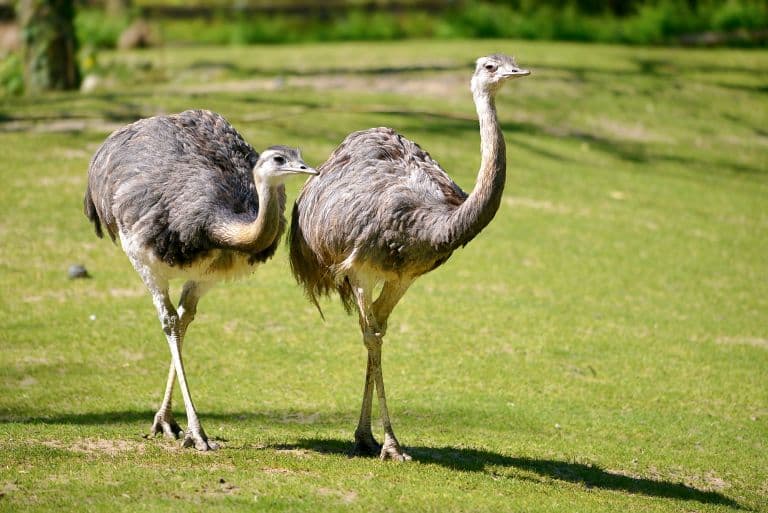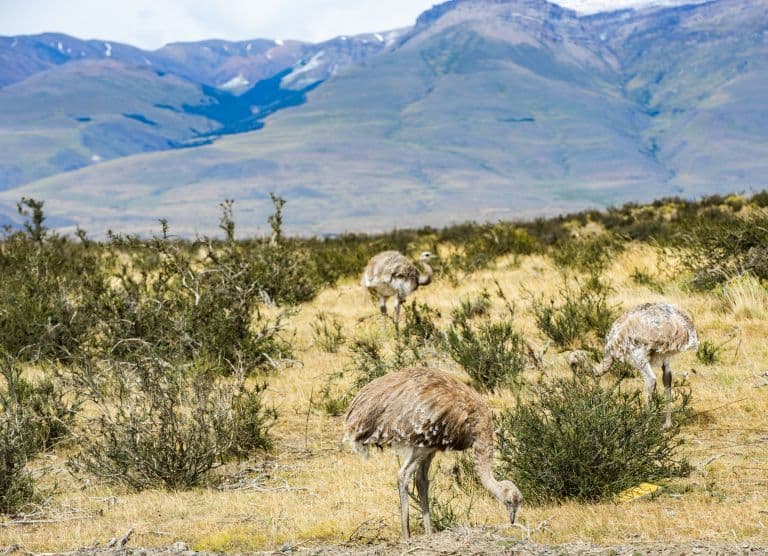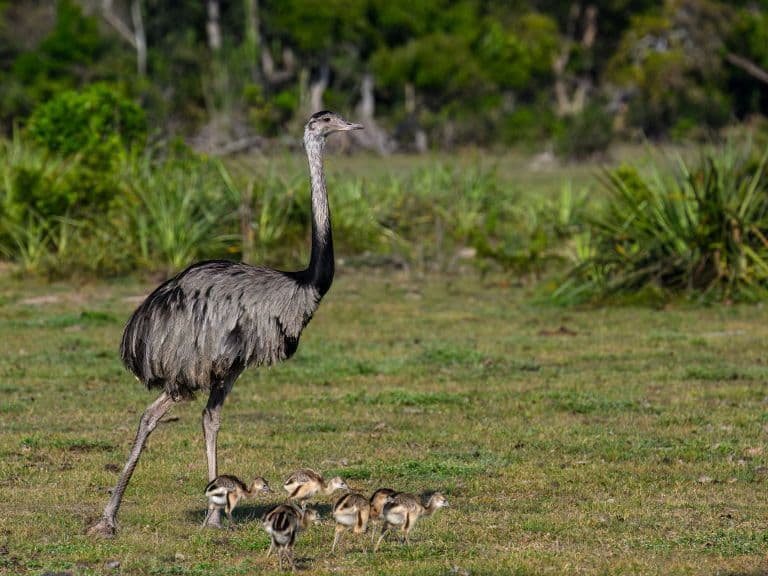Greater Rhea Profile
If you like the look of ostriches but are justifiably anxious about getting under the clawed foot of a 130kg kicking machine, there’s an entry-level alternative from South America that has a lot of the charm and far less of the psychotic terror hissing.
Rheas are the ostrich’s more docile cousin, and while native to South America, you might not have to go as far afield to find one in the wild.
The greater rhea is a species of large, flightless bird, and is the larger of the two species of rhea. It’s commonly known as the American rhea, the common rhea, or the grey rhea.

Greater Rhea Facts Overview
| Habitat: | Grassland, semi-arid scrubland |
| Location: | From Central Brazil to Patagonia, Northern Germany |
| Lifespan: | 15 years in the wild |
| Size: | 1.4m (55 inches) tall |
| Weight: | Up to 27kg (60lb) |
| Colour: | Long, grey feathers with black patches |
| Diet: | Grasses, seeds, fruits |
| Predators: | Cougars, humans, feral dogs |
| Top Speed: | Around 60 km/h (37 mph) |
| No. of Species: | 1 |
| Conservation Status: | Near Threatened (IUCN) |
The Rhea americana is more than just the hottest bird South of Havana, it’s a member of an incredible lineage of fearsome giants, most of which have now gone extinct.
Superficially resembling an ostrich, these are much smaller, cuter and less dangerous cousins from South America.
They inhabit a variety of open grasslands, savanna and wetlands – often with tall vegetation. They will diet on plants, seeds, and fruit, as well as insects, reptiles and small mammals.
Rheas have legs for days. They’re extremely well-adapted to run fast and for a long time, have a sloppy kiss and have formed small communities in Northern Germany.
Interesting Greater Rhea Facts
1. They’re ratites
Ratites are a fascinating group of flightless running birds that include not only the largest extant birds but also the largest there has ever been. Ostriches take the current leader spot, but a 650kg, 3-meter elephant bird once roamed Madagascar, and they were just one of many giants across the globe.
It was once assumed that these birds had all been part of a single common ancestor, running around the supercontinent Gondwana before it broke up into the continents we know today. The hypothesis was that since they couldn’t fly, they must have ended up separated by these enormous distances by the tectonic activity of the Earth.
But more recently, researchers are leaning more towards the idea that they once could fly, and in doing so, radiated onto various landmasses that had been recently vacated by the extinction of the non-avian dinosaurs.
Upon arrival, they found plenty of food, a distinct lack of predators, and lots of room to grow to epic proportions, so they lost their calorically expensive ability to fly and went to town on all the resources.
Only the kiwi remained dainty and cute, the others evolved into rather frightening, usually huge, long-distance sprinters. Rheas are medium-sized: big enough to be scary in a dark alley, but not really massive enough to kick a person to death as an ostrich might. 1

2. Greater rhea are the largest native bird to South America
These graceful giants can stand up to 5.9 feet (1.8 meters) tall and weigh up to 88 pounds (40 kilograms).
While they can have a similar mass to the lesser rhea, they often appear larger and are taller due to longer legs, and neck.
The greater rhea came 7th in our largest birds in the world list, just behind two species of ostrich and cassowary, the emu and emperor penguin.
3. Their name is derived from a greek goddess
The greater rhea gets its scientific name from ‘Rhea’, a Greek goddess and latinized word for America (in reference to their location).
The reason for choosing Rhea is unknown, but Rhea was the Titaness daughter of the earth goddess Gaia and the sky god Uranus and was known as ‘the mother of gods’.
4. They have a lot of saliva
This might be something you’d take for granted but in birds, a wet tongue in birds is the exception rather than the rule. Birds do salivate, but usually more at the back of the mouth than the front, giving tongues a strange sort of leathery feel to them.
Rheas, more like ducks and geese, have a lot of salivary glands, and this gives a far wetter experience when French kissing one. 2
5. They can run 37 mph (60 kph)
For reference, Usain Bolt only reaches speeds up to 43.99 kilometers per hour!
Like most ratites, rheas are hugely cursorial. In the absence of wings, they have developed specialised legs that carry their shaggy bodies all over the place with remarkable efficiency.
Rheas are the largest running bird in South America, and they have the drumsticks to match. But calves are the hardest place to gain mass, and these birds know that all too well.
Rheas’ thighs have several large groupings of muscles, but their lower leg is reduced to mostly bone. This distribution is actually a useful adaptation to increase the speed of the leg, allowing them to get more strides in quick succession.
And their hips don’t lie, either. Hams and glutes are thicc in these birds; this is another way they’re well designed for explosively extending the hip during high-speed locomotion. 3 4
6. They’re good breeders
Rheas are all about efficiency, and this extends to their breeding habits too. Like ostriches, rheas are polygynous, meaning that a single male will breed with multiple females. In exchange for this rich selection, he builds a nest and incubates the eggs – up to 50 of them!
But the females, too, will mate with multiple males if possible, laying clutches in various nests hosted by different males.
The number of eggs each female lays is determined by how young and fat she is, and if a male feels like the work of incubation is too much, he might delegate the job to lower-ranking males instead.
All in all, this is quite a complex yet very effective mating strategy that has ensured rheas’ eggs are not all in one basket. 5
7. Social networks
Ratites tend to have the most dino-like vocal repertoires, and rheas are no exception. Breeding male rheas will make a loud dipping boom in their throats to attract females. His harem may consist of up to 12 females.
During this time, groups will be more fragmented, as males will try to monopolise on the selection of females, but outside of the breeding season, they can be quite social.
Groups of over 25 birds will forage together outside of mating season, but these will usually be formed of females and juvenile males. Mature males tend to be more solitary between mating seasons, only gathering when it’s time to build a nest.

8. They’ve been reduced by farmers
Traditionally, South American hunters would chase the birds on horseback and hunt with bolases, using their hides and meat as a staple, but modern hunting picked up in recent decades and contributed to local extinctions and a near-threatened global population.
In the ’80s, rheas were extensively killed for their skins. These were made into cloaks and raw leather, and exported in the tens of thousands.
This uptick in rhea hunting led to the greater rhea being reclassified by the IUCN as “Near Threatened” and in decline.
These effects are compounded by the increase in habitat destruction from human agriculture, particularly cattle. Conversions of the rhea’s native grasslands into ranching pastures have fragmented and removed significant swathes of their available space.
But the situation may be worse still, as the global population is skewed by a small and persistent group of European escapees. 6
9. They’ve invaded Germany
Normally, farmers can be readily criticised for setting up shop in a native animal’s habitat and then complaining about the native animals being there, but in Germany, rapeseed farmers are getting a bad deal.
A group of female rheas, along with a single male, escaped from a private zoo in Germany and were capable of surviving the colder climate. Over two decades of breeding, they’ve reached a comfortable and increasing feral population of over 600 birds.
They have thoroughly made the place their home, to the dismay of local farmers, whose crops are on the menu for the birds. With no natural predators and plenty of space to expand, it remains to be seen whether they will be classified as an invasive species in the region.
So far, since they don’t threaten native species in any way – mostly because native species have already been decimated in Europe – they’re considered non-invasive and may even prove to be a welcome introduction to the ecosystem. 7
Greater Rhea Fact-File Summary
Scientific Classification
| Kingdom: | Animalia |
| Phylum: | Chordata |
| Class: | Aves |
| Order: | Rheiformes |
| Family: | Rheidae |
| Genus: | Rhea |
| Species: | Rhea Americana |
Fact Sources & References
- Florian Maderspacher (2017), “Evolution: Flight of the Ratites”, Science Direct.
- Tatiana Carlesso Santos (2011), “Light and Scanning Electron Microcopy Study of the Tonguein Rhea americana”, BioOne Digital Library.
- M. B. J. Picasso (2010), “The Hindlimb Muscles of Rhea americana (Aves, Palaeognathae, Rheidae)”, Wiley Online Library.
- Pantanal BirdClub (2010), “Greater Rhea running”, YouTube.
- M.C. Lábaque (2010), “Effect of age and body weight of Greater Rhea (Rhea americana) females on egg number, size and composition”, Taylor & Francis Online.
- “Greater Rhea”, IUCN Red List.
- DW News (2021), “Flightless South American greater rhea wreaks havoc in Germany”, YouTube.
